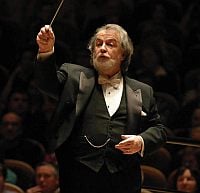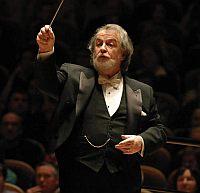
It was in keeping with the upbeat theme of the evening that Mozart’s jovial spirits held sway. My only quibble about the programming was that every movement was in a major key, and I longed for the contrast of, say, the F-sharp minor slow movement of the A-major Piano Concerto, where Mozart confides his sorrows. But despite this, the concert held as much variety as I might have wished, and, as has often been remarked, Mozart is the only composer besides Schubert who can make you cry in a major key.
The F-major Piano Concerto, K. 459 (miscalled the “Coronation” in the program), does sigh a bit in its middle movement, but in Seymour Lipkin’s hands the piece, written in the composer’s 28th year, was boisterous humor all the way, and whatever minor modulations it contained were clearly transitory. The tempos were on the quick side and the performance felt a little breathless. The cadenzas, while brilliantly tossed off, neither stopped the action nor sounded extemporaneous (as they were meant to be), despite the fact that Mozart later wrote them down.
The slow movement, which contains many lovely passages, felt hurried, and this compromised the dialogue between piano and orchestra somewhat, as if the piano was being too impatient about its entrances. In the finale, however, Lipkin and Cleve were in sync and clearly having great fun matching each other’s uproarious contrapuntal escapades.
First-chair French horn David Sprung (who in the three other pieces on the program took time off from his duties as a member of the band) showed how mellow and soothing a brass instrument can be when heard in vocal terms. This seemed to demonstrate Mozart’s musical credo. I found myself thinking, “Yes, this is what music is all about — singing!” Mozart’s phrasing can effortlessly spin long lines that seem to say everything without a note too many or too few. Here the tempos seemed to coincide with the capacity of human lungs, which in Sprung’s case seem to lean toward the superhuman. The second movement, marked “Romanza,” was just that, and it breathed love in every bar; the orchestral accompaniment showed as much sensitivity and responsiveness as did the solo part.
Maximus Out of Minimus
The two symphonies belonged to Cleve, who seemed to draw increasing vitality from the orchestra, which was made up of many of the Bay Area’s most talented instrumentalists. He uses a minimum of motion, often not even shifting his feet for an entire development section, only then turning briefly to cue a section, and always returning to his center, which seems to radiate energy upward.I thought of this while listening to the melodies in the A-major Symphony, K. 183, written when Mozart was but 18 years of age. The upward-striving themes, emblematic of life and growth, overcome the impediments in their way, treating ensemble problems as minor technical imperfections easily overcome by the grace that Mozart so abundantly gave them. The work seemed as fresh as it must have on the day he wrote it down.
This “Jupiter” Symphony, the last he lived to complete, was not of course written in a day; it probably took all of several days to get it down on paper. In this performance it had verve, freedom, and a sense of structure that was miraculous. It was full of wonderful details, too numerous to count and beautifully executed by every section. I might single out the perfect balancing of the brass with the trumpets at the end of the first movement, the winds’ intonation in the Minuet, and the lovely whispered passages of the slow movement.
Naturally, it’s the Finale that sends everyone out in a state of exaltation that I have cherished since childhood when, in Modesto, as a regular listener to a Bay Area classical music radio station now defunct, we were enjoined at 6 o’clock each morning with a cheerful: “Wolfgangers, arise!” Whereupon we were to face in the direction of Salzburg and whistle something by Mozart.

